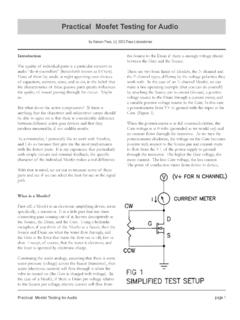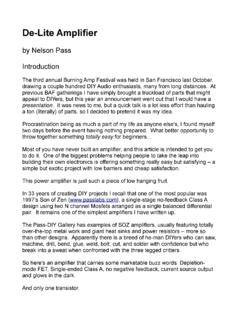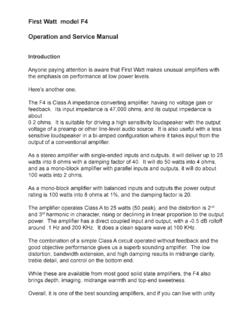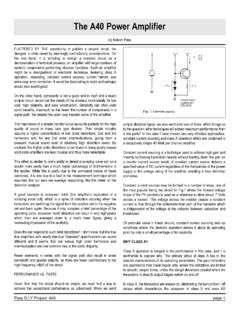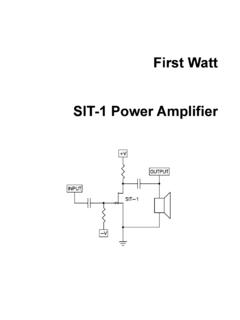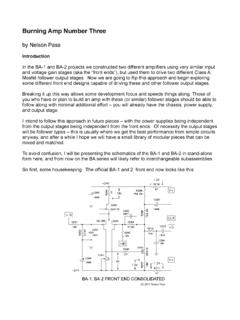Transcription of The Sony VFET Amplifier 40 Year Commemorative
1 The Sony VFET Amplifier 40 Year CommemorativeBy Nelson PassIntroductionThis is about audio power amplifiers, more specifically about those made with a special type of transistor known originally as a VFET, now more commonly referred to as a Static Induction Transistor (SIT).In the 1960's silicon power transistors began to replace tubes in audio power amplifiers, being more convenient in a number of ways. The transistors themselves were smaller, less costly, more efficient and they needed less external hardware to make them were some complaints about their sonic performance in audio amplifiers as compared to tubes, and some efforts were made to give transistors a more Triode-like character.
2 (1) Similar efforts and discussions about them continue to this day. In 1972 a patent application was filed by Junichi Nishizawa describing a special type of JFET (Junction Field Effect Transistor) where the drain-current to drain-voltage characteristic simulates the anode-current to anode-voltage characteristic of the triode vacuum tube very closely. (2)Examples of vfets were produced by Sony and Yamaha forty years ago and appeared in power amplifiers produced from about 1975 through 1980(3). These amplifiers are now prized for their exceptional sound, the credit popularly going to the linearity of the vfets (4). They were called vfets at the time because they have a vertical (not lateral) structure.
3 The subsequent invention and dominance of vertical MOSFETs (Metal Oxide Semiconductor Field Effect Transistor) made use of the term confusing, so now they are generally referred to as Static Induction Transistors (SIT), except perhaps as reference to these original transistors were also exceptionally fast as switches, and in 1976 Sony also produced an early version of the Class D audio Amplifier , the TA-N88.(5)(6)By the 1980's Sony and Yamaha ceased production of VFET amplifiers. Various reasons for this have been offered, the most likely being that production of these exotic parts was considered too expensive to compete with the cheaper vertical MOSFETs which appeared on the vfets ?
4 It's all about the curves. The properties of a gain device are often described by lines on a two dimensional graphic. The location and shape of these lines can give some insight into the performance of the part, providing a map of the territory, the roads, rivers, hills and valleys , which the gain device navigates while doing the job of amplifying the audio a tube, this could be a graph of the amount of current going from the Plate to Cathode versus the voltage from Plate to Cathode at a given voltage between the Grid to Cathode. Here is an example for a power Triode:The vertical axis is the current in milli-Amperes, and the horizontal axis is the Plate to Cathode voltage.
5 The multicolored family of lines show how the current through the tube varies with voltage for eleven examples of a fixed Grid to Cathode voltage from 0 Volts to -100 Volts. These curves have a shape common to all see in these curves that the current through the device is dependent on both the voltage across the device and also the control voltage, which is the voltage between the Grid (control pin) and the Cathode of the tube. In this sense we can imagine the Triode acting as if it were a voltage-controlled resistor, that is to say that the tube acts somewhat like a resistor whose value is dependent on the voltage between the Grid and the Cathode.
6 If you vary the voltage, then the apparent resistance of the Triode varies, and current flows through the tube in proportion to the voltage across the Plate and Cathode. In this way, amplification of a signal is Triode curve is contrasted with the curve of a typical MOSFET transistor:Here we see the curves of the current going from Drain to Source (vertical axis) versus voltage from the Drain to Source pins, each colored line reflecting a different voltage from the Gate to Source pins. The tube/FETpins are analogous: Plate/Drain, Cathode/Source and can see that the lines are flattened out. The current through the MOSFET from Drain to Source is less dependent on the Drain-Source voltage and the device is a voltage-controlled current source.
7 The current through the device is mostly dependent on the Gate to Source course this is also a very useful device for amplification, and you will find many amplifiers using MOSFETs just as you will also find many amplifiers using Bipolar transistors, whose characteristics bear some similarity to FETs except that they are mostly current-controlled current sources, not there are tubes that look a lot like MOSFETs they are called way of cutting through what may be mounting confusion for the reader, I will simply say that each of these types of device has a type of curve, and each type of curve tends to give rise to a characteristic sound. On top of that, each type of device can be used in many ways, giving a very rich tend to have opinions about the subjective qualities of these devices and circuits.
8 A sizable minority of the audiophile population favors the sound of tube amplifiers, and many of those prefer the sound of there have been efforts to make voltage and current controlled current source transistors sound like Triodes, the most direct way is to use a device which has that characteristic to begin with. These are called vfets or became interested in using SIT devices some years ago in a conversation with Semi-South's Jeff Casady and he mentioned that the company was capable of a custom production run of SIT devices rendered in Silicon Carbide. All it would take is a large check. Some months later I was the happy owner of several boxes of N channel SIT devices with my name on them and began working with low power prototype amplifiers which operated single-ended Class A, an appropriate use of devices which resemble the same time I managed to also acquire samples of other parts and ultimately somebody pointed me to a company in Singapore which had an inventory of complementary Sony vfets left over from the 1970's.
9 All it took was another big check, and I found myself in possession of several boxes of 2SK82 and 2SJ28 VFET is the curve to a Sony 2SK82 VFET, showing its voltage controlled resistor character, on a graph which conveniently sits in the range which is suitable for driving your average loudspeaker, something that tubes do not do:Another thing that tubes do not do is that there are no mirror images devices. The Plate is always positive with respect to the Cathode, and until we invent a Positron tube, it is likely to stay that way. However, transistors can be made as complementary (mirror image) parts, and the 2SJ28 is like the 2SK82 but with all the voltages and currents in reverse.
10 This is very convenient, as it makes it very easy to build direct-coupled push-pull amplifiers with simple is a photo of a pair of those Sony 2SK82 and 2SJ28 complementary matched pairs, part of inventory which sat on the shelf for the last forty I began working with these transistors as well, and the first result was an Amplifier presented at the 2013 Burning Amp Festival in San Francisco. It was a push-pull Class A circuit consisting of only three parts, one each of the 2SK82 and 2SJ28 and a small Jensen coupling transformer. (This did not count the power supplies). It delivered 20 watts at reasonably good gain and low distortion and did so without feedback.
